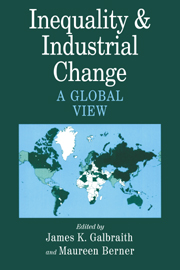Book contents
- Frontmatter
- Contents
- Contributors
- Permissions
- Acknowledgments
- PART I INTRODUCTION TO THEORY AND METHOD
- 1 The Macroeconomics of Income Distribution
- 2 Measuring Inequality and Industrial Change
- PART II INEQUALITY, UNEMPLOYMENT, AND INDUSTRIAL CHANGE
- PART III INEQUALITY AND DEVELOPMENT
- PART IV METHODS AND TECHNIQUES
- Data Appendix
- References and Selected Bibliography
- Index
2 - Measuring Inequality and Industrial Change
Published online by Cambridge University Press: 05 June 2012
- Frontmatter
- Contents
- Contributors
- Permissions
- Acknowledgments
- PART I INTRODUCTION TO THEORY AND METHOD
- 1 The Macroeconomics of Income Distribution
- 2 Measuring Inequality and Industrial Change
- PART II INEQUALITY, UNEMPLOYMENT, AND INDUSTRIAL CHANGE
- PART III INEQUALITY AND DEVELOPMENT
- PART IV METHODS AND TECHNIQUES
- Data Appendix
- References and Selected Bibliography
- Index
Summary
This chapter introduces in nontechnical terms the principal techniques used in this book: Theil's T statistic, cluster analysis, and discriminant function analysis.
Introduction
How does one measure whether one society is more equal than another? Or whether an economy is more equal than it had been in the past? Equality is a broad concept with many layers of meaning: There is equality and inequality in legal rights, in social and political standing, and in many matters of culture. And even within the economic dimension, one may focus on inequalities of wealth, of family income, of individual earnings, and of wage rates. Each of these has its own importance, and each is measured from different sources of data and in slightly different ways.
Most of the theoretical literature on economic inequality is concerned with the determinants of pay: with wage rates and employment prospects, which together determine earnings in particular industries and occupations. Pay rates and job openings are a characteristic of the employer and the workplace. Yet most of the empirical work on inequality derives from surveys whose focus is on employees and their households, which are aimed mainly at assessing the distribution of family or household income. This is an important, even vital, issue, obviously: The distribution of household income is a key social fact. Yet data sources based on household surveys of income only indirectly provide information about the distribution of wage rates.
- Type
- Chapter
- Information
- Inequality and Industrial ChangeA Global View, pp. 16 - 30Publisher: Cambridge University PressPrint publication year: 2001
- 1
- Cited by



